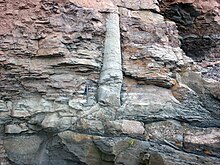User:AutomaticPlant/sandbox
| Stigmaria Temporal range: Carboniferous to Permian
| |
|---|---|
| Scientific classification | |
| Kingdom: | |
| Division: | |
| Class: | |
| Order: | |
| Genus: | Stigmaria Broningart, 1822
|



Stigmaria is a form taxon for common fossils found in Carboniferous rocks.[1] They represent the underground rooting structures of coal forest lycopsid trees such as Sigillaria and Lepidodendron. These swamp forest trees grew to 50 meters and were anchored by an extensive network of branching underground structures with "rootlets" attached to them. Analysis of the morphology and anatomy of these stigmarian systems suggests they were shoot-like and so they are called rhizomes or rhizophores. The stigmarian rhizomes are typically covered with a spiral pattern of circular scars where "rootlets" were attached. Since the stigmarian systems are shoot-like, these "rootlets" may be modified leaves, adapted to serve the function of roots. However, some paleontologists argue that the "rootlets" were true roots, with a complex branching structure and root hairs, comparable to the roots of the closest living relative of Lepidodendron, the quillworts (genus Isoetes).[2]
Anatomy[edit]
Stigmaria consisted of four primary axes sprouting from the lycopsid base and moving horizontally in four different directions. These primary axes, like the arboreal axes, grew in dichotomous branches that gradually penetrated the soil and created extensive subterranean dichotomous structures. From these primary structures sprouted smaller structures, termed 'rootlets' (although it is not known if they are true roots), which were arranged in a helical pattern around the primary structures and were shed as the structures grew, leaving distinctive scars in their wake. The anatomy of primary Stigmarian axes has proved different from the anatomy of their subsequent secondary rootlets, provoking significant discussion among Paleobotanists about their anatomical identities and evolutionary histories.
Primary axes consisted of a woody vascular cambium concealing both primary and secondary xylem, as well as a parenchymatous pith. The primary xylem is arranged in bands. Secondary xylem tracheids are scalariform, and have fibrils identical to those in the arboreal section of the plant. Stigmaria had no secondary phloem. Production of secondary cortical tissues in the primary axes are distinguished by a narrow zone of periderm appearing similar to periderm in the central stem.
Secondary axes ('rootlets')
References[edit]
- ^ Rothwell, GW; Erwin, DM (1985). "The rhizophore apex of Paurodendron: implications for homologies among the rooting organs of Lycopsida". American Journal of Botany. 72: 86–98. doi:10.2307/2443571.
- ^ Hetherington, AJ; Berry, CM; Dolan, Liam (June 14, 2016). "Networks of highly branched stigmarian rootlets developed on the first giant trees" (PDF). PNAS. 113 (24): 6695–6700. doi:10.1073/pnas.1514427113. PMC 4914198. Retrieved 15 February 2017.
Category:Lycophytes Category:Carboniferous plants Category:Prehistoric plants of North America Category:Fossils of Georgia (U.S. state) Category:Paleozoic life of New Brunswick Category:Paleozoic life of the Northwest Territories Category:Paleozoic life of Nova Scotia

